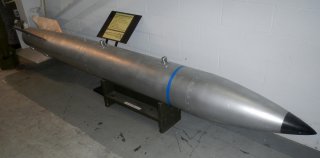America's Old Nuclear Bombs are Getting an Upgrade
The Air Force is also integrating the B61 Mod 12 nuclear weapon into the F-35A this year as part of a long-range plan to deploy a nuclear-armed, dual-capable F-35 able to give commanders a wider envelope of precision nuclear attack options.
Here's What You Need To Remember: The B61 bomb is almost sixty years old and is as "dumb" as it gets. The upgraded version will come with substantial improvements, giving Air Force units greater discretion in how to deploy and launch the bombs.
The Air Force is working with Boeing to sustain and improve an advanced variant of the B61 air-dropped nuclear bomb, engineered to give pilots much-expanded attack options with which to hold potential adversaries at risk from the air. The Air Force just awarded Boeing a continued development deal for the weapon.
In recent years, The Air Force has been test-dropping the upgraded, multi-function B61-12 nuclear bomb which improves accuracy, integrates various attack options into a single bomb and changes the strategic landscape with regard to nuclear weapons mission possibilities.
The B61-12 adds substantial new levels of precision targeting and consolidates several different kinds of attack options into a single weapon. Instead of needing separate variants of the weapon for different functions, the B61-12 by itself allows for earth-penetrating attacks, low-yield strikes, high-yield attacks, above surface detonation and bunker-buster options.
The latest version of the B61 thermonuclear gravity bomb, which has origins as far back as the 1960s, is engineered as a low-to-medium yield strategic and tactical nuclear weapon, according to nuclearweaponsarchive.org, which also states the weapon has a “two-stage” radiation implosion design.
Air Force officials describe this, in part, by referring to the upgraded B61-12 as having an “All Up Round.”
The B61 Mod 12 is engineered with a special “Tail Subassembly” to give the bomb increased accuracy, giving a new level of precision targeting using Inertial Navigation Systems, according to information from the Nuclear Information Project, Federation of American Scientists.
Right now, the B-2 carries only B61-7 (10-360 kt), B61-11(400 kt, earth-penetrator), and B83-1 (high-yield bunker-buster). The B61-12 covers all of those missions. The evidence that the B61-12 can penetrate below the surface has significant implications for the types of targets that can be held at risk with the bomb.
By bringing an “earth-penetrating” component, the B61-12 vastly increases the target scope or envelope of attack. It can enable more narrowly targeted or pinpointed strikes at high-value targets underground—without causing anywhere near the same level of devastation above ground or across a wider area.
The testing and integration of the B61-12 is one piece of a massive, fleet-wide B-2 upgrade designed to sustain the bomber into coming years, until large numbers of the emerging B-21 Raider are available. A range of technical modifications are also intended to prepare the 1980s-era bomber for very sophisticated, high-end modern threats.
The B-2 is getting improved digital weapons integration, new computer processing power reported to be 1,000-times faster than existing systems and next-generation sensors designed to help the aircraft avoid enemy air defenses. One of the effort’s key modifications is designed to improve what’s called the bomber’s Defensive Management System, a technology designed to help the B-2 recognize and elude enemy air defenses, using various antennas, receivers and display processors.
The Air Force is also integrating the B61 Mod 12 nuclear weapon into the F-35A this year as part of a long-range plan to deploy a nuclear-armed, dual-capable F-35 able to give commanders a wider envelope of precision nuclear attack options.
The Block 4 F-35 will fully emerge in the next decade and contains more than 50 technical adjustments to the aircraft designed as software and hardware builds. These will be added in six-month increments between April 2019 to October 2024, Air Force officials explained.
Kris Osborn is the defense editor for the National Interest. Osborn previously served at the Pentagon as a Highly Qualified Expert with the Office of the Assistant Secretary of the Army—Acquisition, Logistics & Technology. Osborn has also worked as an anchor and on-air military specialist at national TV networks. He has appeared as a guest military expert on Fox News, MSNBC, The Military Channel, and The History Channel. He also has a Masters Degree in Comparative Literature from Columbia University. This article first appeared in June 2020.
Image: Wikimedia Commons.

